
Home - Search - Browse - Alphabetic Index: 0- 1- 2- 3- 4- 5- 6- 7- 8- 9
A- B- C- D- E- F- G- H- I- J- K- L- M- N- O- P- Q- R- S- T- U- V- W- X- Y- Z
Eurostar 2000
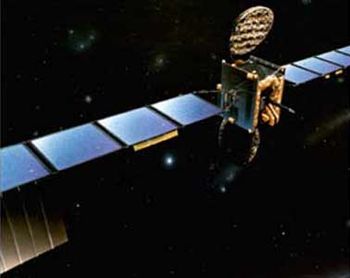 Orion 1 Credit: Manufacturer Image |
AKA: Afristar;Asiastar. Status: Operational 1988. First Launch: 1988-03-11. Last Launch: 2006-11-08. Number: 24 . Gross mass: 3,000 kg (6,600 lb).
The Eurostar 2000 platform was the second generation of Matra Marconi Space GEO satellite platforms serving mainly commercial telecommunications applications. The Eurostar 2000 bus was available in both basic and enhanced (Eurostar 2000+) versions. The platform was designed for high performance, reliability and cost effectiveness.
The main features of Eurostar included high versatility (2 to 6 metric tons launch mass, flexible power range) substantial payload accommodation, stable and accurate pointing and high autonomy. The Eurostar 2000 series were built at Marconi's facility in Toulouse, France. The Eurostar series could meet customer needs for fixed services/broadcast, mobile services, and interactive broadband and military applications.
Specification, Eurostar 2000 basic:. Dry mass 1200-1900 kg; launch mass 1600-2300 kg; payload mass 400 kg; payload available power 2-4 kw; 3 Axis stabilization; chemical bi-propellant propulsion. Mission lifetime 12 years.
Specification, Eurostar 2000 plus:. Dry mass 1750-2850 kg; launch mass 2300-3400 kg; payload mass 550 kg; payload available power 4-7 kw; 3 Axis stabilization; chemical bi-propellant propulsion with plasma, ion capability. Mission lifetime 12 years.
More at: Eurostar 2000.
| TTlTcom 2A, 2B, 2C, 2D Null |
| Hispasat 1A, 1B Communication satellite built by Matra Marconi for Hispasat, Spain. Launched 1992 - 1993. Used the Eurostar-2000 bus. |
| Orion 1 / Telstar 11 Null |
| Hot Bird 2, 3, 4, 5 / Eurobird 2, 9&rarr Null |
| 4, 10, 16 / Atlantic Bird 4 Null |
| Nilesat 101, 102 Communication satellite built by Astrium for Nilesat, Egypt. Launched 1998 - 2000. Used the Eurostar-2000 bus. |
| ST 1 Communication satellite built by Astrium for Singapore Telecom (SingTel), Chunghwa Telecom, Singapore. Launched 1998. Used the Eurostar-2000+ bus. |
| AfriStar 1, 2, AsiaStar, WorldStar 4 Communication satellite built by Alcatel Space (prime), Astrium (bus) for WorldSpace Corp., USA. Launched 1998 - 2000. Used the Eurostar-2000+ bus. |
| Eutelsat W1 / Eurobird 4A / Eutelsat 4A Null |
| Astra 2B Communication (Direct Broadcasting) satellite built by Astrium for SES, Luxembourg. Launched 2000. Used the Eurostar-2000+ bus. |
| Hot Bird 7 Communication (Direct Broadcasting) satellite built by Astrium for Eutelsat, International. Launched 2002. Used the Eurostar-2000+ bus. |
| HellasSat 2 Communication satellite built by Astrium for Hellas Sat, Greece. Launched 2003. Used the Eurostar-2000+ bus. |
| Arabsat 4A, 4B, 4AR / Badr 1, 4, 6 Null |
Family: Communications, Geosynchronous orbit. Country: France. Spacecraft: Orion. Launch Vehicles: Atlas, Proton, Ariane, Ariane 2/3, Ariane 3, Ariane 44LP, Ariane 44L, Ariane 42P, Ariane 44P, Atlas IIA, Ariane 5, Ariane 5G, Atlas V, Proton-M/Briz-M, Atlas V 401, Ariane 5ECA. Projects: Americom, Astra, Eutelsat, Hispasat, ST, Telecom, WorldSpace. Launch Sites: Cape Canaveral, Baikonur, Cape Canaveral LC36A, Cape Canaveral LC36B, Cape Canaveral LC41, Kourou, Kourou ELA1, Baikonur LC200/39, Kourou ELA2, Kourou ELA3. Agency: France Telecom, Nilesat, Matra Marconi. Bibliography: 2, 276, 278, 4, 552, 554, 6, 12334, 12335, 12336, 12337, 12338, 12339, 12340, 12341, 12342, 12343, 12344, 12345.
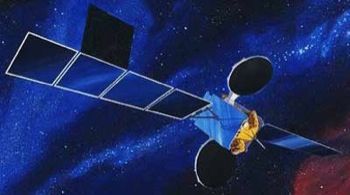 | Afristar Credit: Manufacturer Image |
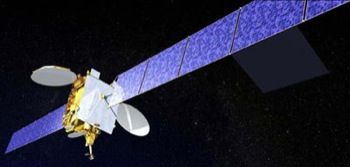 | Badr 4 ARABSAT 4B Credit: Manufacturer Image |
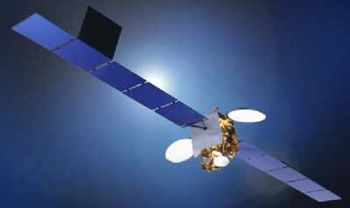 | Astra 2B Credit: Manufacturer Image |
 | Eutelsat W1 Credit: Manufacturer Image |
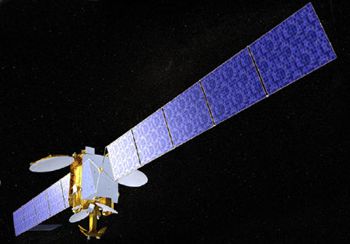 | Hellas Sat 2 Credit: Manufacturer Image |
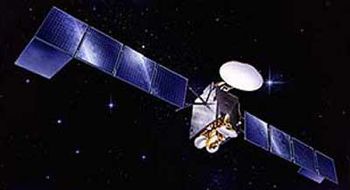 | Hispasat 1A Credit: Manufacturer Image |
 | Hot Bird 2 Credit: Manufacturer Image |
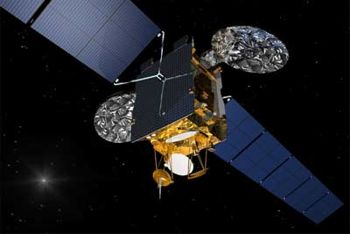 | Hot Bird 7 Credit: Manufacturer Image |
 | Nilesat 1 Credit: Manufacturer Image |
 | ST-1 Credit: Manufacturer Image |
 | Telecom 2A Credit: Manufacturer Image |
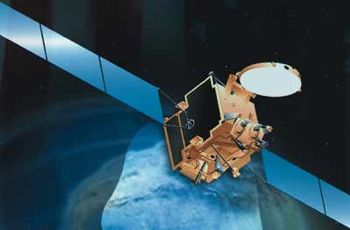 | GE 5 Credit: Manufacturer Image |
1988 March 11 - . 23:28 GMT - . Launch Site: Kourou. Launch Complex: Kourou ELA1. LV Family: Ariane. Launch Vehicle: Ariane 3.
- Telecom 1C - .
Mass: 1,210 kg (2,660 lb). Nation: France.
Agency: GTE.
Manufacturer: Toulouse.
Program: Telecom.
Class: Communications.
Type: Civilian communications satellite. Spacecraft: Eurostar 2000.
Completed Operations Date: 1996-03-22 . USAF Sat Cat: 18952 . COSPAR: 1988-018B. Apogee: 36,860 km (22,900 mi). Perigee: 36,037 km (22,392 mi). Inclination: 5.50 deg. Period: 1,470.10 min.
French domestic communications; 5 deg E. Communications satellite. Registration France 1984-2.B (Telecom 1A) 1985-2.B (Telecom 1B). 1988-1-C (Telecom 1C). Positioned in geosynchronous orbit at 5 deg W in 1988-1992; 3 deg E in 1992-1996 As of 5 September 2001 located at 109.19 deg W drifting at 8.404 deg W per day. As of 2007 Mar 10 located at 34.65E drifting at 8.341W degrees per day.
1991 December 16 - . 23:19 GMT - . Launch Site: Kourou. Launch Complex: Kourou ELA2. LV Family: Ariane. Launch Vehicle: Ariane 44L.
- Telecom 2A - .
Mass: 2,275 kg (5,015 lb). Nation: France.
Agency: France Telecom.
Manufacturer: Toulouse.
Program: Telecom.
Class: Communications.
Type: Civilian communications satellite. Spacecraft: Eurostar 2000.
USAF Sat Cat: 21813 . COSPAR: 1991-084A. Apogee: 35,801 km (22,245 mi). Perigee: 35,773 km (22,228 mi). Inclination: 0.10 deg. Period: 1,436.10 min.
French communications; 3 deg E. Positioned in geosynchronous orbit at 3 deg E in 1992; 8 deg W in 1992-1999 As of 5 September 2001 located at 8.05 deg W drifting at 0.004 deg W per day. As of 2007 Mar 11 located at 111.59E drifting at 4.763W degrees per day.
1992 April 15 - . 23:25 GMT - . Launch Site: Kourou. Launch Complex: Kourou ELA2. LV Family: Ariane. Launch Vehicle: Ariane 44L.
- Telecom 2B - . Mass: 2,200 kg (4,800 lb). Nation: France. Agency: France Telecom. Manufacturer: Toulouse. Program: Telecom. Class: Communications. Type: Civilian communications satellite. Spacecraft: Eurostar 2000. USAF Sat Cat: 21939 . COSPAR: 1992-021A. Apogee: 35,804 km (22,247 mi). Perigee: 35,769 km (22,225 mi). Inclination: 0.00 deg. Period: 1,436.10 min. Stationed at 3 deg E. Positioned in geosynchronous orbit at 5 deg W in 1992-1999 As of 5 September 2001 located at 24.98 deg E drifting at 0.634 deg E per day. As of 2007 Mar 9 located at 77.10W drifting at 2.683W degrees per day..
1992 September 10 - . 23:04 GMT - . Launch Site: Kourou. Launch Complex: Kourou ELA2. LV Family: Ariane. Launch Vehicle: Ariane 44LP.
- Hispasat 1A - . Mass: 2,194 kg (4,836 lb). Nation: Spain. Agency: Hispasat. Manufacturer: Toulouse. Program: Hispasat. Class: Communications. Type: Civilian communications satellite. Spacecraft: Eurostar 2000. USAF Sat Cat: 22116 . COSPAR: 1992-060A. Apogee: 35,794 km (22,241 mi). Perigee: 35,784 km (22,235 mi). Inclination: 0.10 deg. Period: 1,436.20 min. Stationed at 30 deg W. Positioned in geosynchronous orbit at 30 deg W in 1992-1999 As of 3 September 2001 located at 29.99 deg W drifting at 0.013 deg W per day. As of 2007 Mar 10 located at 83.37E drifting at 3.458W degrees per day..
1993 July 22 - . 22:58 GMT - . Launch Site: Kourou. Launch Complex: Kourou ELA2. LV Family: Ariane. Launch Vehicle: Ariane 44L.
- Hispasat-1B - . Mass: 2,120 kg (4,670 lb). Nation: Spain. Agency: Hispasat. Manufacturer: Toulouse. Program: Hispasat. Class: Communications. Type: Civilian communications satellite. Spacecraft: Eurostar 2000. USAF Sat Cat: 22723 . COSPAR: 1993-048A. Apogee: 35,794 km (22,241 mi). Perigee: 35,780 km (22,230 mi). Inclination: 0.00 deg. Period: 1,436.10 min. Stationed at 30 deg W. Positioned in geosynchronous orbit at 30 deg W in 1993-1999 As of 5 September 2001 located at 30.13 deg W drifting at 0.024 deg W per day. As of 2007 Mar 8 located at 157.75E drifting at 1.953W degrees per day..
1994 November 29 - . 10:21 GMT - . Launch Site: Cape Canaveral. Launch Complex: Cape Canaveral LC36A. LV Family: Atlas. Launch Vehicle: Atlas IIA.
- Orion 1 - .
Mass: 2,358 kg (5,198 lb). Nation: USA.
Manufacturer: Toulouse.
Program: Orion.
Class: Communications.
Type: Civilian communications satellite. Spacecraft: Eurostar 2000.
USAF Sat Cat: 23413 . COSPAR: 1994-079A. Apogee: 35,792 km (22,240 mi). Perigee: 35,781 km (22,233 mi). Inclination: 0.00 deg. Period: 1,436.10 min.
34 Ku-band transponders for TV. Stationed at 37.48 deg W. Launch vehicle put payload into supersynchronous earth orbit with IFR trajectory option. Positioned in geosynchronous orbit at 37 deg W in 1994-1999 As of 5 September 2001 located at 37.54 deg W drifting at 0.010 deg W per day. As of 2007 Mar 11 located at 37.60W drifting at 0.015W degrees per day.
1995 December 6 - . 23:23 GMT - . Launch Site: Kourou. Launch Complex: Kourou ELA2. LV Family: Ariane. Launch Vehicle: Ariane 44L.
- Telecom 2C - . Mass: 2,283 kg (5,033 lb). Nation: France. Agency: France Telecom. Manufacturer: Toulouse. Program: Telecom. Class: Communications. Type: Civilian communications satellite. Spacecraft: Eurostar 2000. USAF Sat Cat: 23730 . COSPAR: 1995-067A. Apogee: 35,793 km (22,240 mi). Perigee: 35,777 km (22,230 mi). Inclination: 0.10 deg. Period: 1,436.10 min. Stationed at 1.1 deg E. Positioned in geosynchronous orbit at 3 deg E in 1996-1999 As of 5 September 2001 located at 5.05 deg W drifting at 0.004 deg W per day. As of 2007 Mar 11 located at 3.02E drifting at 0.001E degrees per day..
1996 August 8 - . 22:49 GMT - . Launch Site: Kourou. Launch Complex: Kourou ELA2. LV Family: Ariane. Launch Vehicle: Ariane 44L.
- Telecom 2D - . Mass: 2,150 kg (4,730 lb). Nation: France. Agency: France Telecom. Manufacturer: Toulouse. Program: Telecom. Class: Communications. Type: Civilian communications satellite. Spacecraft: Eurostar 2000. USAF Sat Cat: 24209 . COSPAR: 1996-044B. Apogee: 35,803 km (22,246 mi). Perigee: 35,771 km (22,227 mi). Inclination: 0.20 deg. Period: 1,436.10 min. Positioned in geosynchronous orbit at 3 deg E in 1996; 5 deg W in 1996-2000; 8 deg W in 2000.- As of 5 September 2001 located at 7.90 deg W drifting at 0.004 deg W per day. As of 2007 Mar 9 located at 7.85W drifting at 0.005W degrees per day..
1996 November 21 - . 20:47 GMT - . Launch Site: Cape Canaveral. Launch Complex: Cape Canaveral LC36A. LV Family: Atlas. Launch Vehicle: Atlas IIA.
- Hot Bird 2 - .
Payload: Eurostar 2000+. Mass: 2,900 kg (6,300 lb). Nation: France.
Agency: Eutelsat.
Manufacturer: Toulouse.
Program: Eutelsat.
Class: Communications.
Type: Civilian communications satellite. Spacecraft: Eurostar 2000.
USAF Sat Cat: 24665 . COSPAR: 1996-067A. Apogee: 35,803 km (22,246 mi). Perigee: 35,768 km (22,225 mi). Inclination: 0.00 deg. Period: 1,436.10 min.
Geostationary at 13.0E. Launch vehicle put payload into supersynchronous earth orbit with IFR/MRS trajectory option. Positioned in geosynchronous orbit at 13 deg E in 1997-1999 As of 3 September 2001 located at 12.95 deg E drifting at 0.024 deg E per day. As of 2007 Mar 4 located at 13.07E drifting at 0.011E degrees per day.
1997 September 2 - . 22:21 GMT - . Launch Site: Kourou. Launch Complex: Kourou ELA2. LV Family: Ariane. Launch Vehicle: Ariane 44LP.
- Hot Bird 3 - . Payload: Eurostar 2000+. Mass: 2,900 kg (6,300 lb). Nation: Europe. Agency: Eutelsat. Manufacturer: Toulouse. Program: Eutelsat. Class: Communications. Type: Civilian communications satellite. Spacecraft: Eurostar 2000. USAF Sat Cat: 24931 . COSPAR: 1997-049A. Apogee: 35,806 km (22,248 mi). Perigee: 35,762 km (22,221 mi). Inclination: 0.10 deg. Period: 1,436.00 min. Geosynchronous. Stationed over 13.3E Positioned in geosynchronous orbit at 13 deg E in 1997-1999 As of 3 September 2001 located at 12.96 deg E drifting at 0.012 deg E per day. As of 2007 Mar 11 located at 3.94E drifting at 0.003W degrees per day..
1998 February 27 - . 22:38 GMT - . Launch Site: Kourou. Launch Complex: Kourou ELA2. LV Family: Ariane. Launch Vehicle: Ariane 42P.
- Hot Bird 4 - . Payload: Eurostar 2000+. Mass: 2,900 kg (6,300 lb). Nation: Europe. Agency: Eutelsat. Manufacturer: Toulouse. Program: Eutelsat. Class: Communications. Type: Civilian communications satellite. Spacecraft: Eurostar 2000. USAF Sat Cat: 25237 . COSPAR: 1998-013A. Apogee: 35,797 km (22,243 mi). Perigee: 35,773 km (22,228 mi). Inclination: 0.00 deg. Period: 1,436.00 min. Geostationary at 13.0 degrees E. Positioned in geosynchronous orbit at 13 deg E in 1998-1999 As of 2 June 2001 located at 14.35 deg E drifting at 0.065 deg E per day. As of 2007 Mar 9 located at 7.18W drifting at 0.004W degrees per day..
1998 April 28 - . 22:53 GMT - . Launch Site: Kourou. Launch Complex: Kourou ELA2. LV Family: Ariane. Launch Vehicle: Ariane 44P.
- Nilesat 1 - .
Payload: Nilesat 101. Mass: 1,827 kg (4,027 lb). Nation: Egypt.
Agency: Nilesat.
Manufacturer: Toulouse.
Program: Nilesat.
Class: Communications.
Type: Civilian communications satellite. Spacecraft: Eurostar 2000.
USAF Sat Cat: 25311 . COSPAR: 1998-024A. Apogee: 35,800 km (22,200 mi). Perigee: 35,773 km (22,228 mi). Inclination: 0.00 deg. Period: 1,436.10 min.
Egypt's first satellite. Geostationary at 7.0 degrees W. Positioned in geosynchronous orbit at 7 deg W in 1998-1999 As of 5 September 2001 located at 6.95 deg W drifting at 0.003 deg W per day. As of 2007 Mar 10 located at 7.00W drifting at 0.007W degrees per day.
1998 August 25 - . 23:07 GMT - . Launch Site: Kourou. Launch Complex: Kourou ELA2. LV Family: Ariane. Launch Vehicle: Ariane 44P.
- ST-1 - .
Payload: Eurostar 2000+. Mass: 3,200 kg (7,000 lb). Nation: Singapore.
Agency: Arianespace.
Manufacturer: Toulouse.
Program: Singapore,
Taiwan.
Class: Communications.
Type: Civilian communications satellite. Spacecraft: Eurostar 2000 .
USAF Sat Cat: 25460 . COSPAR: 1998-049A. Apogee: 35,804 km (22,247 mi). Perigee: 35,771 km (22,227 mi). Inclination: 0.10 deg. Period: 1,436.10 min.
Singapore-Taiwan-1 Matra Marconi Space Eurostar 2000 class satellite to provide communications for Singapore Telecom and Chunghwa Telecom of Taiwan. Geostationary at 88.0 degrees E. Positioned in geosynchronous orbit at 88 deg E in 1998-1999 As of 5 September 2001 located at 88.04 deg E drifting at 0.009 deg W per day. As of 2007 Mar 10 located at 88.05E drifting at 0.007W degrees per day.
1998 October 9 - . 22:50 GMT - . Launch Site: Cape Canaveral. Launch Complex: Cape Canaveral LC36B. Launch Pad: SLC36B. LV Family: Atlas. Launch Vehicle: Atlas IIA.
- Hot Bird 5 - . Payload: Eurostar 2000+. Mass: 3,000 kg (6,600 lb). Nation: France. Agency: Eutelsat. Manufacturer: Toulouse. Program: Eutelsat . Class: Communications. Type: Civilian communications satellite. Spacecraft: Eurostar 2000. USAF Sat Cat: 25495 . COSPAR: 1998-057A. Apogee: 35,807 km (22,249 mi). Perigee: 35,764 km (22,222 mi). Inclination: 0.10 deg. Period: 1,436.00 min. Geostationary at 10.0 degrees E. Positioned in geosynchronous orbit at 13 deg E in 1998-1999 As of 3 September 2001 located at 12.97 deg E drifting at 0.010 deg E per day. As of 2007 Mar 11 located at 25.56E drifting at 0.014W degrees per day..
1998 October 28 - . 22:15 GMT - . Launch Site: Kourou. Launch Complex: Kourou ELA2. LV Family: Ariane. Launch Vehicle: Ariane 44L.
- Afristar - .
Payload: Eurostar 2000+. Mass: 2,750 kg (6,060 lb). Nation: France.
Agency: Worldspace.
Manufacturer: Toulouse.
Program: WorldSpace.
Class: Communications.
Type: Civilian communications satellite. Spacecraft: Eurostar 2000.
USAF Sat Cat: 25515 . COSPAR: 1998-063A. Apogee: 35,805 km (22,248 mi). Perigee: 35,769 km (22,225 mi). Inclination: 0.00 deg. Period: 1,436.10 min.
Afristar was the first WorldSpace satellite. Afristar was to broadcast digital radio over Africa and the Middle East. Small hand-held radios could pick up the 24 to 96 radio channels available on the three L-band beams. Dry mass of Afristar was 1205 kg; it carried 1534 kg of propellant at launch. Geostationary at 21.0 degrees E. Positioned in geosynchronous orbit at 21 deg E in 1998-1999 As of 3 September 2001 located at 20.98 deg E drifting at 0.004 deg W per day. As of 2007 Mar 10 located at 20.98E drifting at 0.010W degrees per day.
- GE 5 - .
Mass: 1,720 kg (3,790 lb). Nation: USA.
Agency: GE Americom.
Manufacturer: Cannes.
Program: Americom.
Class: Communications.
Type: Civilian communications satellite. Spacecraft: Eurostar 2000.
USAF Sat Cat: 25516 . COSPAR: 1998-063B. Apogee: 35,808 km (22,250 mi). Perigee: 35,765 km (22,223 mi). Inclination: 0.00 deg. Period: 1,436.10 min.
Satellite was originally built as a backup for Argentina's Nahuelsat. This allowed Dornier and Alcatel to deliver the satellite in a record twelve months. Dry mass of GE 5 was 769 kg - it carried 950 kg of propellant at launch. Geostationary at 36.4 degrees W. Positioned in geosynchronous orbit at 79 deg W in 1998-1999 As of 3 September 2001 located at 79.00 deg W drifting at 0.004 deg W per day. As of 2007 Mar 10 located at 78.99W drifting at 0.011W degrees per day.
2000 March 21 - . 23:28 GMT - . Launch Site: Kourou. Launch Complex: Kourou ELA3. LV Family: Ariane 5. Launch Vehicle: Ariane 5G.
- Asiastar - .
Payload: Eurostar 2000+. Mass: 2,778 kg (6,124 lb). Nation: Europe.
Agency: Worldspace.
Manufacturer: Toulouse.
Program: Worldspace.
Class: Communications.
Type: Civilian communications satellite. Spacecraft: Eurostar 2000.
USAF Sat Cat: 26107 . COSPAR: 2000-016A. Apogee: 35,805 km (22,248 mi). Perigee: 35,770 km (22,220 mi). Inclination: 0.10 deg. Period: 1,436.10 min.
Direct Radio Broadcasting satelllite. First night launch of Ariane 5. Worldspace's second digital radio satellite. Joined Afristar in orbit with a mission of providing radio broadcasting to the developing world. Stationed at 105 deg E. Positioned in geosynchronous orbit at 105 deg E in 2000. As of 4 September 2001 located at 104.96 deg E drifting at 0.015 deg W per day. As of 2007 Mar 9 located at 104.99E drifting at 0.012W degrees per day.
2000 August 17 - . 23:16 GMT - . Launch Site: Kourou. Launch Complex: Kourou ELA2. LV Family: Ariane. Launch Vehicle: Ariane 44LP.
- Nilesat 102 - .
Mass: 1,827 kg (4,027 lb). Nation: Egypt.
Agency: Nilesat.
Manufacturer: Toulouse.
Program: Nilesat.
Class: Communications.
Type: Civilian communications satellite. Spacecraft: Eurostar 2000.
USAF Sat Cat: 26470 . COSPAR: 2000-046B. Apogee: 35,797 km (22,243 mi). Perigee: 35,775 km (22,229 mi). Inclination: 0.00 deg. Period: 1,436.10 min.
Geosynchronous communications satellite of the Egyptian company Nilesat SA. The satellite joined Nilesat 101 in providing Ku-band broadcast services. Stationed at 7 deg W. Positioned in geosynchronous orbit at 7 deg W in 2000. As of 2 September 2001 located at 6.98 deg W drifting at 0.002 deg W per day. As of 2007 Mar 9 located at 6.97W drifting at 0.004W degrees per day.
2000 September 6 - . 22:33 GMT - . Launch Site: Kourou. Launch Complex: Kourou ELA2. LV Family: Ariane. Launch Vehicle: Ariane 44P.
- Eutelsat W1 - .
Mass: 3,250 kg (7,160 lb). Nation: Europe.
Agency: Eutelsat.
Manufacturer: Toulouse.
Program: Eutelsat.
Class: Communications.
Type: Civilian communications satellite. Spacecraft: Eurostar 2000.
USAF Sat Cat: 26487 . COSPAR: 2000-052A. Apogee: 35,812 km (22,252 mi). Perigee: 35,760 km (22,220 mi). Inclination: 0.20 deg. Period: 1,436.10 min.
European Telecommunications Satellite Organization's Eutelsat W1 was launched into a geostationary transfer orbit, targetted for a final 10 deg E orbital position. The box-shaped 2.5 x 5.0 m satellite has two rectangular solar panel arrays spanning 31.7m and two dishes, a European beam and a steerable beam. The payload includes 28 Ku-band transponders. Stationed at 10 deg E. Positioned in geosynchronous orbit at 1 deg E in 2000. As of 1 September 2001 located at 9.92 deg E drifting at 0.005 deg E per day. As of 2007 Mar 8 located at 10.05E drifting at 0.006W degrees per day.
2000 September 14 - . 22:54 GMT - . Launch Site: Kourou. Launch Complex: Kourou ELA3. LV Family: Ariane 5. Launch Vehicle: Ariane 5G.
- Astra 2B - .
Payload: Eurostar 2000+. Mass: 3,320 kg (7,310 lb). Nation: Europe.
Agency: SES.
Manufacturer: Toulouse.
Program: Astra.
Class: Communications.
Type: Civilian communications satellite. Spacecraft: Eurostar 2000.
USAF Sat Cat: 26494 . COSPAR: 2000-054A. Apogee: 35,801 km (22,245 mi). Perigee: 35,772 km (22,227 mi). Inclination: 0.10 deg. Period: 1,436.10 min.
Direct Broadcasting satellite. Launch postponed from July 25. Astra 2B was an Astrium/Toulouse Eurostar 2000+ television broadcast satellite owned by the Luxembourg-based Societe Europeene de Satellites. The satellite was to be stationed at 28.2E to replace the German DFS Kopernikus. It carried 28 Ku-band transponders. By September 19 Astra 2B was in a 31,153 x 35,762 km x 0.3 deg orbit, approaching geosynchronous altitude. Stationed at 28 deg E. Positioned in geosynchronous orbit at 28 deg E in 2000. As of 20 August 2001 located at 28.50 deg E drifting at 0.011 deg E per day. As of 2007 Mar 10 located at 28.15E drifting at 0.017W degrees per day.
2002 December 11 - . Launch Site: Kourou. Launch Complex: Kourou ELA3. LV Family: Ariane 5. Launch Vehicle: Ariane 5ECA. FAILURE: The Ariane 5 core's Vulcain-2 engine began failing at T+178 seconds. The rocket veered off course and the destruct signal was sent.. Failed Stage: 1.
- Hot Bird 7 - . Payload: Eurostar 2000+. Mass: 3,350 kg (7,380 lb). Nation: Europe. Agency: Eutelsat. Manufacturer: Friedrichshafen. Program: Eutelsat. Class: Communications. Type: Civilian communications satellite. Spacecraft: Eurostar 2000. Maiden flight of Ariane 5 EC-A. Delayed from October, November 20 and 28. Hot Bird 7, a Eutelsat geostationary communications satellite, was lost in the failed first flight of the Ariane 5 EC-A. Value of the lost satellite was Euro 250 million..
2003 May 13 - . Launch Site: Cape Canaveral. Launch Complex: Cape Canaveral LC41. Launch Pad: SLC41. LV Family: Atlas V. Launch Vehicle: Atlas V 401.
- Hellas Sat 2 - . Mass: 3,440 kg (7,580 lb). Nation: Greece. Agency: Hellas. Class: Communications. Type: Civilian communications satellite. Spacecraft: Eurostar 2000. USAF Sat Cat: 27811 . COSPAR: 2003-020A. Apogee: 35,800 km (22,200 mi). Perigee: 35,775 km (22,229 mi). Inclination: 0.10 deg. Period: 1,436.20 min. Launch delayed from January 30, March 11 and 14, May 10 and 12, 2003. Spacecraft former Intelsat KTV, NSS-KTV, NSS-6, Intelsat APR-3. As of 2007 Mar 8 located at 38.95E drifting at 0.006E degrees per day..
2006 February 28 - . 20:10 GMT - . Launch Site: Baikonur. Launch Complex: Baikonur LC200/39. LV Family: Proton. Launch Vehicle: Proton-M/Briz-M. FAILURE: Briz-M stage shut down 27.5 minutes into a planned 31-minute burn and could not be restarted. The failure left the satellite in a useless orbit from which it quickly decayed... Failed Stage: U.
- Arabsat 4 - . Payload: Eurostar 2000+. Mass: 3,341 kg (7,365 lb). Nation: Arab States. Agency: Arabsat. Manufacturer: EADS Astrium. Program: Arabsat. Class: Communications. Type: Civilian communications satellite. Spacecraft: Eurostar 2000. Decay Date: 2006-03-24 . USAF Sat Cat: 28943 . COSPAR: 2006-006A. Apogee: 14,684 km (9,124 mi). Perigee: 497 km (308 mi). Inclination: 51.60 deg. Period: 273.80 min. The satellite seperated from the stage but the mission could not be rescued. It was ordered to fire its apogee engine around 00:20 GMT on March 24 to lower its perigee into the atmosphere. It reportedly burned up over the South Pacific at 02:07 GMT..
2006 November 8 - . 20:01 GMT - . Launch Site: Baikonur. Launch Complex: Baikonur LC200/39. LV Family: Proton. Launch Vehicle: Proton-M/Briz-M.
- Badr 4 ARABSAT 4B - . Payload: Eurostar 2000+. Mass: 3,280 kg (7,230 lb). Nation: Arab States. Agency: Arabsat. Manufacturer: EADS Astrium. Class: Communications. Type: Civilian communications satellite. Spacecraft: Eurostar 2000. USAF Sat Cat: 29526 . COSPAR: 2006-051A. Apogee: 35,807 km (22,249 mi). Perigee: 35,764 km (22,222 mi). Inclination: 0.10 deg. Period: 1,436.00 min. Dry mass 1487 kg. The satellite provided Ku-band communications services for Arab League countries. As of 2007 Mar 10 located at 26.06E drifting at 0.011E degrees per day..
Back to top of page
Home - Search - Browse - Alphabetic Index: 0- 1- 2- 3- 4- 5- 6- 7- 8- 9
A- B- C- D- E- F- G- H- I- J- K- L- M- N- O- P- Q- R- S- T- U- V- W- X- Y- Z
© 1997-2019 Mark Wade - Contact
© / Conditions for Use